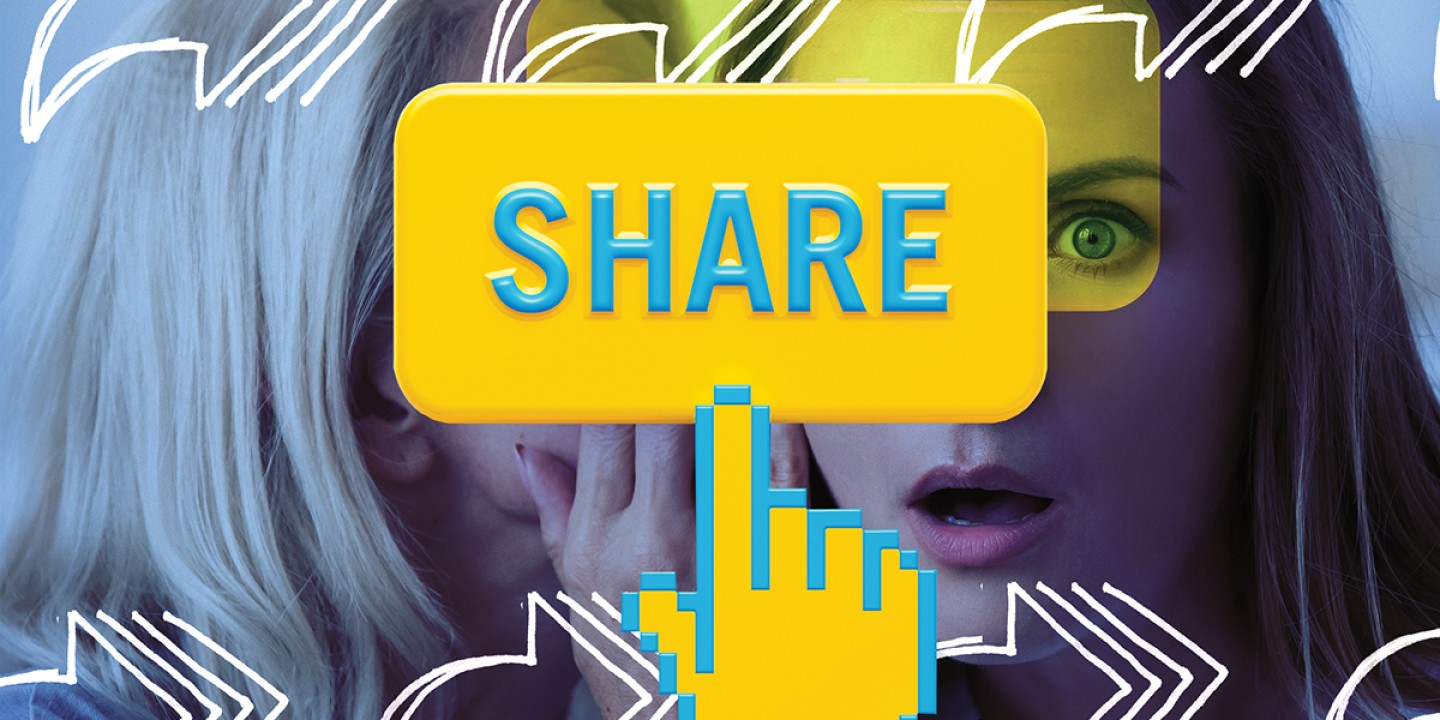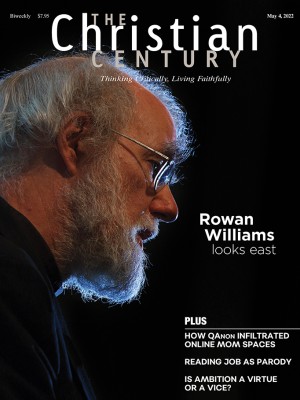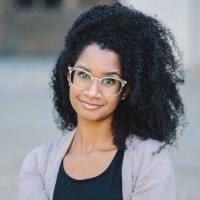QAnon moms
The infiltration of online parenting spaces began as a slow burn. During the pandemic, it’s picked up speed.

It didn’t take long after becoming a mother for 31-year-old Tanna Leclaire to realize that the internet can be a tricky place for new parents looking for resources or support.
Leclaire has a distinct memory of searching YouTube for advice on potty training her three-year-old daughter after a book failed to give her the in-the-trenches tips she really wanted. She watched a few potty training videos before the YouTube algorithm recommended a video on dealing with toddler tantrums. Leclaire clicked on it without hesitation. Next, the algorithm began offering her videos on child safety.
“And then that turned into: here are all the people who are out to get your kids. And, by the way, they might be people who drink babies’ blood or whatever,” she said. “It goes out into left field so fast—two or three videos.”
The infiltration by QAnon—a web of far-right conspiracy theories alleging that Donald Trump was elected president in order to save the nation from a cadre of blood-drinking, pedophilic liberal elites—into online parenting spaces has been a slow burn. But it seems to have taken off in the last two years, likely fueled by parallel anti-vaccine and anti-mask conspiracy theories related to the COVID-19 pandemic.
Read our latest issue or browse back issues.
Moderators and managers of online parenting spaces say that since 2020 they’ve noticed an uptick in the number of comments and posts that either explicitly include or make reference to QAnon ideas. This despite the fact that Q, the alleged government insider who provides QAnon followers with “top secret” intel to decode, has broken his silence only once since the 2020 election—a seemingly devastating blow to the movement.
Like other supporters of the movement, the social media moms of QAnon are mostly White and largely evangelical. And, as Leclaire found out, their YouTube videos and Instagram posts are usually innocuous—how to create a Montessori playroom, how to get ready in five minutes, tips for a successful homeschooling day—but are sometimes peppered with less benign content. There’s the offhand statement about how COVID-19 vaccines contain tracking devices, or how Hollywood celebrities are participating, en masse, in a child sex-trafficking ring.
Many of the women who confidently disseminate misinformation about vaccines or human trafficking don’t even realize that what they’re sharing is part of a larger and darker conspiracy theory. In fact, a 2020 study by Tufts University political science professor Brian Schaffner found that most people who believe in core QAnon tenets are totally unfamiliar with QAnon itself.
And that’s no accident, said Mike Rothschild, author of The Storm Is upon Us: How QAnon Became a Movement, Cult, and Conspiracy Theory of Everything.
QAnon began in 2017 when an anonymous account started posting cryptic messages known as Q-drops to online forums like 4chan and 8chan (now 8kun) and signing them Q. But, according to Rothschild, the person or persons behind Q quickly realized that these forums, notorious as they are for their racism, antisemitism, and mass shooter manifestos, might limit the ability of QAnon ideas to seep into more mainstream culture.
As an antidote, they also began utilizing mainstream social media, which provided a layer of insulation between the very worst of the forums and the new people they wanted to bring into the QAnon fold. On a platform like Twitter or Facebook, “you could read the drops, you could interpret them, you could talk about them,” Rothschild said, “but you never had to go to the actual place where they were being posted, because there was all this other horrible crap there, too.”
This strategy was successful. QAnon supporters took to social media, generating tens of millions of tweets and thousands of Facebook groups, and the built-in algorithms on these platforms quickly helped push QAnon content to more people.
The thing about social media platforms is that they are designed to keep users on their sites, and one way they do this is by recommending more and more content related to a user’s supposed beliefs and interests. Join a Facebook group about holistic medicine, and Facebook might recommend another group about essential oils. Join the essential oils group, and Facebook might show you an anti-vaccine group. Join the anti-vaccine group, and Facebook might suggest a pro-Trump QAnon group.
In 2020, the Wall Street Journal reported that as early as 2016, Facebook knew that its own recommendation tools were responsible for 64 percent of all membership growth in extremist groups on the site.
It was primarily through the co-opting of the existing hashtag #savethechildren that many White, suburban mothers ended up in the QAnon web. Originally, the hashtag had been used as a fundraising tool for Save the Children, a 100-year-old nonprofit that advocates for children’s rights around the globe. But in summer 2020, QAnon supporters began using it as part of an awareness campaign against the trafficking of children.
While experts maintain that trafficking victims almost always come from vulnerable populations—recent migrants, runaways, or those with addictions—in QAnon and adjacent circles, all children are at risk at all times.
That summer, many well-meaning mothers began sharing doctored maps that allegedly detailed the prevalence of human trafficking. They were also banning Disney movies in their homes because of the company’s purported involvement in trafficking children for celebrities. They were boycotting the online furniture company Wayfair for ostensibly hiding ads for children in its listings for cabinets. And, despite the pandemic, these mothers were attending in-person Save the Children rallies across the country.
Many of 2020’s #savethechildren tweets were innocuous. Human trafficking, after all, is a real issue. But each tweet increased the hashtag’s popularity, and those who kept digging into it pretty soon found themselves in the murky world of QAnon and its other conspiracy theories. And some of these women became hardcore believers and proselytizers.
“Something like Q makes you feel like you are fighting a battle against the worst people who want to do harm to your kids,” Rothschild said. “This is God versus Satan, and we’re on the side of God . . . and we’re finally going to take them down and save our children. It’s not even saving the children. It’s saving our children. It’s protecting ourselves.”
Rothschild notes that not everyone is susceptible to this kind of apocalyptic narrative. Generally, he said, it’s people who are already suspicious of institutions. People like homesteaders, anti-vaxxers, and anti-5G activists.
Homeschooling moms have been singled out as another demographic that’s particularly susceptible to QAnon—perhaps because many of them are White evangelicals whose reasons for home education include protecting their children from the “liberal agenda” and “government overreach” they see as rampant in public schools.
And indeed, homeschooling moms on the internet are QAnon believers. Their social media posts might outline their homeschooling schedule; they also might suggest that the reason children have been asked to wear masks at school is to make them easier to kidnap and traffic.
But it’s here that Delina Pryce McPhaull, creator of the Oh Freedom! homeschool history curriculum, would like to offer some nuance. Black Americans are also largely suspicious of authority and institutions, but they “have receipts,” she said—they have long-standing and good reasons for their suspicion. Yet few have gotten on board with QAnon.
McPhaull is something of a professional institutional doubter herself. A Black, longtime homeschooling mother of three, she began selling her curriculum for other homeschoolers in 2019. Since then, the curriculum has generated its own multiracial community of “woke homeschoolers” of all races who want to push back against the whitewashed way US history has traditionally been taught.
What McPhaull sees in the way that conservative, White, Christian homeschoolers have embraced QAnon is something deeper than simply distrust of authority. It’s a fear of the other.
“I think the reason they are attracted to QAnon is not wanting to be tainted by the world—and what ‘the world’ means to them is foreigners, Black and Brown people, the LGBTQ community,” she said.
She notes that when institutional authorities are in agreement with their brand of conservative values, these same people suddenly seem to have no problem with authority. “They’re happy with Trump taking over the country by force,” she said, alluding to the January 6 insurrection at the US Capitol.
It took social media platforms a while to try to curb the influence of the QAnon moms.
In July 2020, Twitter said it would block accounts that tweeted QAnon content. That fall, Facebook said it removed 1,700 pages, 5,600 groups, and 18,700 Instagram accounts related to QAnon. In October 2020, YouTube announced that it was updating its policies to ban conspiracy theories that have been used to “justify real-world violence”—a particular hallmark of QAnon as compared to other conspiracy theories.
But from the perspective of Rothschild and other experts, these measures were too late; the damage had already been done. Furthermore, they didn’t really stop QAnon content. They just pushed it underground.
Some QAnon supporters have fled to alternative social media sites like Rumble, Gab, and Telegram. But others simply create new accounts on the major platforms, this time using savvier, more coded language in order to dodge the algorithms. So, for instance, instead of Q, they’ll write 17—a reference to Q being the 17th letter of the alphabet.
For Tanna Leclaire, the practical implications of all of this have meant that she’s had to develop a system of protections when entering online parenting spaces. On YouTube, she’s quick to click the “do not recommend this channel” option when she comes across what she calls a “fashy”—fascist—account.
She also intentionally follows momfluencers of color—even if their beliefs don’t happen to align entirely with hers—because she knows that way she’s less likely to encounter White supremacist views in her feed. She’s learned to utilize the tool Twitter Block Chain, which allow users to block not only a particular account but also every account that follows or is followed by it.
“It’s just a matter of knowing how to curate your content on a particular content source in the first place and knowing what your red flags are—the things that are not acceptable to you—and shutting that down,” she said.
Leclaire knows firsthand what it’s like to depend on the internet for parenting tips and support. An Episcopalian in a small town, she said the median age of the room at her parish goes down about two decades when she walks in, making it difficult to find relevant parenting experience.
“When I talk to other moms,” she said, “it’s usually—at the very youngest—Gen Xers. And their parenting experience is so, so different from my experience. Let alone the boomers and even the Greatest Generation folks.”
That firsthand experience is also why Leclaire, who does digital evangelism for her church, worries about the women who are less digitally savvy than she is and therefore vulnerable to the insidious ways QAnon weaves its way into parenting content.
Part of the problem, she said, is that there’s no great way to teach media literacy, because technology often moves faster than any education program can be put together.
“You have to be looking to educate yourself, and I don’t think most people have the bandwidth for that. Certainly not new moms,” she said. “I wasn’t doing this kind of deep dive into how QAnon spreads when I had a newborn. All I was doing was trying to survive. “
But it’s here that Leclaire actually sees an opportunity for churches.
“If I could speak out to any mainline pastor: even if you don’t have a ton of moms in your community, get a mommy group going. Get them networking and talking to each other, because even if we’re a minority in a given parish or congregation, we really, really need support out here,” she said.
“If we’re not getting it from our own religious communities, we’re going to be looking for it elsewhere. And a mom that isn’t discerning could end up sliding into some really problematic stuff that is hard to come back from.”







